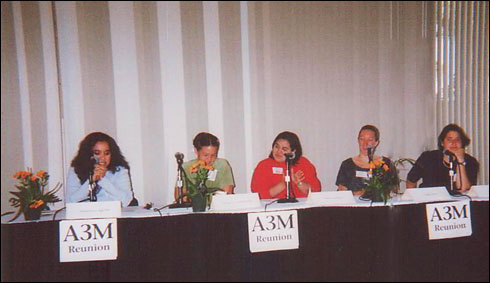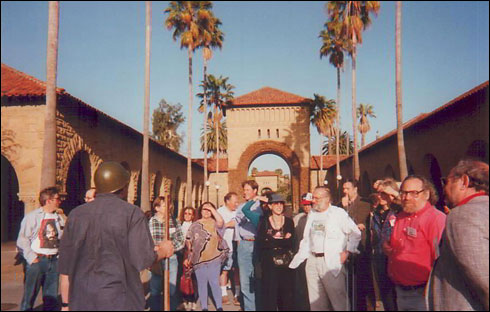April Third Movement
Report on the A3M Thirty-Year Reunion
by Lenny Siegel
From May 7-9, 1999, nearly 150 people who had been active in the anti-war movement and other progressive activity at Stanford in the late 1960s and early 1970s gathered at Tresidder Union to mark the 30th anniversary of the April Third Movement (A3M). Formed on April 3, 1969, the April Third Movement staged two on-campus sit-ins and a militant street demonstration at Hanover Street and Page Mill Road in the Stanford Research Park. One of the high points of activism at Stanford, A3M successfully brought an end to classified military research on campus, but it was unable to force Stanford to halt military and counterinsurgency research at the Stanford Research Institute (SRI), at the time a wholly owned subsidiary of the university.

Participants at the reunion, like many other Stanford events, included doctors, lawyers, journalists, professors, scientists, government officials, and venture capitalists, but union organizers and professional environmentalists were represented as well. We heard from a panel of currrent student activists, followed by a panel of old activists who described how their experiences at Stanford shaped their work today. Another group explained how 60s activism not only helped stop the Vietnam war and promote civil rights, but gave birth to the women’s movement and the personal computer. The participants also engaged in heated debate over the War in Serbia. Though most of the anti-war alums strongly criticized the war—collecting signatures on a petition, once again, to “stop the bombing”—several passionately supported the bombing as “humanitarian intervention.”

On the afternoon of May 8, a group of reunion participants toured the campus sites of past sit-ins, teach-ins, and street battles. At the end of our tour Saturday we staked a makeshift plaque into the ground in the new science quad. It said: .
Former site of the Applied Electronics Laboratory, location of a nine-day sit-in in April, 1969 by 1400 members of the Stanford community, protesting Stanford’s role in the Vietnam War and successfully demanding an end to classified research on campus.
Research life, not death!
THE APRIL THIRD MOVEMENT
30–year reunion, May 8, 1999

Some of the participants talked about lobbying the University and raising money for a more permanent plaque, but thus far nothing has been done.

That night novelist Ed McClanahan read his story, “Another Great Moment in Sports,” to the reunion dinner party. (The story appears in his book, My VITA, If You Will.) It tells how an activist named Norman threw a police tear-gas canister into SRI’s Hanover Street facility, after spending a year or two tossing footballs around in White Plaza. McClanahan called it Norman’s “Clear Moment,” the minute for which he had been preparing for his whole life. Indeed, the events which we gathered to remember—the AEL sit-in, the Hanover Street action, the Cambodia Strike, etc.—were the collective clear moments of the assembled alumni.

Like people at more conventional reunions, we spent a lot of time catching up with old friends, comrades, and flames. But we also looked back at how our days at Stanford had changed our lives and, to some small degree, helped change the world.
May 9, 1999
'60s Protesters Gather, Look Back with No Regrets
San Jose Mercury News article by Barbara Feder